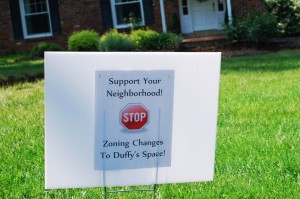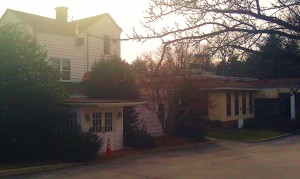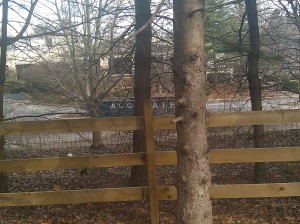A couple of weeks have passed since supervisor JD DiBuonaventuro held a town hall meeting for members of the Daylesford Neighborhood Association (DNA). Also attending the meeting were township manager Mimi Gleason, zoning officer Matt Bauman, supervisors DiBuonaventuro, Michelle Kichline and Kristen Mayock, and planning commissioners Bob O’Leary, Tory Snyder and Trip Lukens. Representing the proposed project were developer Ed Morris, Berwyn Real Estate L.P., Capital Health representative Gerard Farrell and attorney Denise Yarnoff. The focus for the meeting is a 93-bed assisted living facility proposed for the old Jimmy Duffy’s catering site on Lancaster Ave. in Daylesford. The property is 2.069 acres, containing 1.069 acres of C1 Commercial and 1 acre of R1 Residential property. Current zoning does not permit this usage.
The mid-May meeting follows other DNA meetings, planning commission meetings and Board of Supervisor meetings where the assisted living project was discussed. Attending most of the meetings, I have now decided this proposed project represents something more significant than simply a NIMBY (Not-in-My-Back-Yard) syndrome for a local neighborhood. Residents raised questions about the proposed project including traffic, density, lighting, trash collection to name a few. Although certainly important issues to those residents most affected, I was not entirely convinced that an assisted living facility was a bad idea. In an attempt to gain community support, the developer made concessions at the town hall meeting – the latest sketch plan reduced the number of floors, closed off the back exit to adjourning Pennsylvania Ave from the site, enclosed trash collection, etc.
My problem with the Jimmy Duffy redevelopment project has nothing to do with the specific project but rather, the way this project has seemingly been fast-tracked and given a green light to move forward. What do I mean? An assisted living facility is not currently on the list of permitted uses in the township’s C1 district. Because the current zoning does not permit an assisted living facility, traditionally a developer would seek either a variance or a conditional use for the project. When questioned at the October 2011 planning commission meeting as to why the applicant would not take this approach, attorney Denise Yarnoff responded that, “the process would delay the project, cause a financial burden, and not address all the project-related issues.”
If you are a developer and don’t want to see your proposed project bogged down by the time required to seek a variance or conditional use (and don’t want the additional cost this path would require) why not just get Tredyffrin Twp to change the zoning to accommodate your plans. Yes, that is exactly what has happened … an Ordinance Amendment draft to permit assisted living in C1 zoning was submitted by Yarnoff along with a $5,000 application fee. The ordinance amendment is scheduled for the Planning Commission’s July 19 meeting. In researching this situation, I have not been able to find any other project in the township in recent years where zoning usage was changed to accommodate a specific developer and specific project. What is it about this specific project or its developer that would warrant such special treatment by the township? I have no idea.
Anyone that is reading this post needs to recognize that this situation and the ramifications of the proposed zoning change is not just about the Daylesford assisted living project. Should the C1 zoning Ordinance Amendment continue down the green light path, the zoning change will permit assisted living in all C1 districts in the township. Should this ordinance amendment be approved, it means that a zoning change for a specific project, benefiting a specific developer will change the permitted uses for all C1 properties in Tredyffrin Township. So the next question is ‘why’ have a comprehensive plan?
According to the township website, the comprehensive plan “provides local officials with a highly effective planning tool that will support day-to-day decisions about future development so that they may be thoroughly rational and consistent …” I have to ask, is changing zoning to accommodate a specific project “rational” ? A comprehensive plan is in place to guide growth and development in an orderly manner … does changing zoning to accommodate a specific developer’s needs promote a fair and orderly process?
Beyond obvious concern that changing zoning for a specific project is precedent setting for the township, there’s something else. In April, the Board of Supervisors voted unanimously to spend $100,000 for a consultant to update commercial zoning regulations in the township. The consultant was hired to review the township’s existing commercial zoning and make recommendations. Would it not seem to make sense if the township (taxpayers) is spending $100K for professional zoning advice, there should be a moratorium on any zoning changes until after the expert presents his update? That is not to say that this assisted living project couldn’t move forward – the developer would just have to use either the variance or conditional use routes versus the zoning ordinance amendment change.
As follow-up to the town hall meeting, DNA president Trisha Larkin sent a series of questions to supervisor DiBuonaventuro in regards to the proposed assisted living project. A specific question and response from DiBuonaventuro caught my attention –
Larkin:
4. Why is there not a moratorium on commercial zoning (re-zoning) until the independent consultant comes back with some solid recommendations?DiBuonaventuro:
This developer began talking to the Township last year, before a decision was made to begin work on the commercial zoning districts. The commercial zoning work is just beginning and will take another 18 months before it is completed. In fairness to the developer and to the bank that owns the property, a decision needs to be made one way or the other long before the completion of the commercial zoning work so the bank knows whether it should seek a different buyer.
Should the process for a land development project be based on what is ‘fair’ to a developer or the property’s owner (in this case Eagle Bank)? Or … should any proposed land development project be based on what is ‘fair’ to the community and its residents? Zoning decisions must be policed both from the top-down and from the bottom-up, using processes that encourage neighborhood residents to participate actively in decision-making. Citizen participation both gives voice to the interests of neighborhood residents and provides the most effective safeguard against corruption of the zoning process.
The rationale behind municipal zoning power is that effective land use planning is necessary to promote and protect the interests of the entire community. Those making land development decisions need to create the community that we, the residents, want.
I am going to be very curious to see how the assisted living project plays out … will the draft C1 ordinance amendment, as provided by the developer’s attorney, win the approval of the Planning Commissioners and go on to the Board of Supervisors for their final approval? Will DNA residents continue to voice their concerns over the project? Will other township residents view zoning changes to suit a specific project or to accommodate a particular developer as setting precedence … and therefore, worthy of further discussion?
Stay tuned; the outcome on this proposed zoning change may mean a new era for development in Tredyffrin Township.


